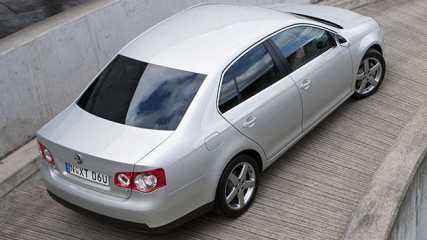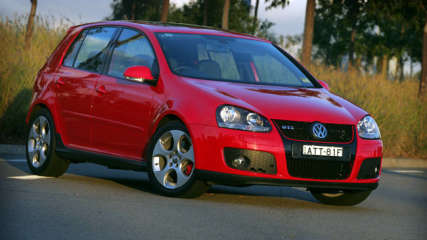Volkswagen Golf 2010 review
By Mark Hinchliffe · 17 Jun 2010
WHAT gets faster and more powerful while getting cheaper and more economical to run? Volkswagen’s Golf R series. And it also arrives here a lot sooner after release. The first R32 model took two years to get here, one year for the Passat R36 and now less than four months.PricingThe new R arrives at sub-$50,000for the three-door manual, which is a far cry from the first R32 that cost $63,000 and the previous R36 at $55,000. Two more doors cost an extra $1500 and DSG costs an extra $2500. VGA marketing manager Jutta Friese says five-door will dominate with 80 to 90 per cent of sales and DSG about 85 per cent as is the case with GTI.DrivetrainWhile VW has gone from a 3.2-litre V6 engine to a two-litre, four-cylinder turbo, the power has gradually gone up from 177kW and 320Nm of torque to 184kW/320Nm in the R32 and now a whopping 188kW/330Nm. Consequently, the 0-100km/h times have also come down from 6.6 seconds to 6.5 (6.2 DSG) and now 5.9 (manual and 5.7 (DSG).VW product marketing manager Valdan Dimic says they prefer to call it ‘downsizing’. “We continually increase the power, increasing acceleration and at the same time optimising significantly the fuel economy from 11.6 to 8.7 (litres per 100km),’’ he says.VW Group Australia boss Anke Koeckler says while the sporty GTI is the top-selling Golf, the R series was the ‘hero’ car with a niche market. “We only expect it to be about 10 to 12 per cent of the Golf sales,’’ she says.MechanicalLike the GTI and GTD there is optional Adaptive Chassis Control ($1500) that modifies the dampers to the terrain and can be selected on the fly for normal, sport or comfort settings. Unlike many of these electronic damper controls in other luxury cars there is a substantial difference between sport and comfort. The suspension has been lowered 25mm over the standard, but in comfort settings it soaks up the worst potholes.Pulling it all to a grinding halt are massive 345mm front brakes which are only 5mm smaller than the brakes on the big R50 SUV. Like past R models, it comes with 4Motion all-wheel drive to differentiate it from the front-wheel-drive GTI. This now features the ability in extreme conditions to transfer 100 per cent of drive through the rear wheels.Styling and fit-outIt arrives with all the usual GT style and there are few clues to picking it from the GTI or new GTD. One of the easiest ways to pick it is through the twin exhausts. They are on either side on the GTI, on one side on the GTD and together in the middle on the R.Look more closely and you will notice new alloys, black brake callipers with the R-logo and a new bumper design. In front, there are three large air intakes painted in high-gloss black. In standard trim, it gets Bi-Xenon headlights, LED daytime running lights, Tinted rear windows and LED rear lights..Inside, there is a flat-bottomed steering wheel, shift paddles, blue needles on instruments, aluminium pedals, aluminium door sills with an R logo and special seats with the R logo in the head rest. “One of the key elements of the interior design is the seats to highlight the sportiness around you,’’ Dimic says.The standard seats have dark-grey Kyalami cloth named after the South African racetrack with ‘San Remo’ microfibre inserts and grey stitching. Leather is a $3300 option and there are $5300 motorsport seats also available.DrivingPlant your foot flat to the floor and there is a delightful explosion out the back every time the DSG box goes up a gear when it hits the limiter. It’s a joyous sound, accompanied by explosive power as the four wheels grip the tarmac and make haste.On the launch in Tasmania last week (June 11) we turned off the highway just out of Launceston and headed up the B roads into a snow flurry in the mountains, gravel roads and black ice. In most cars it would be time to exercise extreme caution, but the R takes it all in its stride with an uncanny amount of grip and tidy manners.A few corners found us ploughing ahead through black ice, but there is nothing much you can do about that. In the main, it turns in tightly – a little tighter with a dab of left foot brake – and stays on line through a corner so long as you keep the throttle on. Lift off and the chassis doesn’t like it, but things never get wild.Steering is neutral and brakes have a bit of a plush initial feel, unlike the bite of the GTI and GTD. Practical people with a wild streak can explain the five-door away as a family car and point to the fuel economy figures. But it’s really that wild ‘R’ streak that we want.VW Golf R historyMk IV R32 launched in Europe in 2002 in limited numbers. Launched in Australia in 2004 at $63,000. R32 has a 3.2-litree V6 with 177kW/320Nm and a 0-100km time of 6.6 seconds Mk V R36: Mk V R36 launched in Europe in 2005 and Australia in 2006 for $55,000. R36 has a 3.2-litre V6 engine with 184kW/320Nm and 6.5/6.2sec (DSG).Mk VI R launched in Europe in February and Australia in June for $48,490 (3-door manual), $50,990 (3-door DSG), $49,990 (5-door man), $52,490 (5-door DSG). R has a 2-litre direct injection, turbo 4-cylinder with 188kW/ 330Nm and 5.9 secs (manual), 5.7 (DSG).









